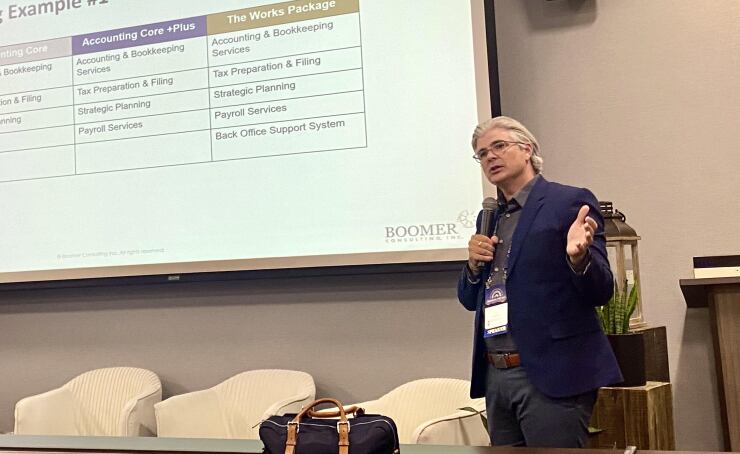Any growth strategy should start with identifying the clients the firm wants to pursue — but don't worry if they're "ideal."
"We have to be really clear on who our target clients are," Jon Hubbard, a shareholder and chief growth officer at Boomer Consulting, recently told a group of accountants. "And note that I'm not saying your 'ideal' clients. That brings a lot of emotional baggage. My grandmother is ideal, but she's not a target client."
Speaking during at a session on "The Tech-Enabled Playbook for Firm Growth" at the 2025 Bridging the Gap Conference this week in Denver, Hubbard stressed the central importance of clearly identifying the firm's target clients, but he recommended taking a step back before diving in and slicing and dicing your current client base in Excel.

"Before you start with spreadsheets, answer these questions," he suggested: "Who do you want more of? What are their best characteristics? What are their most challenging characteristics? What do they value?"
The last two are particularly important to be able to serve your target clients better. For instance, knowing that your "A" clients may demand more of you or expect more proactive service than your Bs or Cs allows you to plan for the extra capacity you'll need as you bring on more As. Similarly, having a better handle on what they value allows you to adjust your deliverables appropriately in advance.
"Often, what you're delivering isn't necessarily what they think they're getting," Hubbard warned.
After answering those first four questions, you can begin considering Hubbard's next three, which are more quantifiable: "How much revenue do they generate for the firm? What are three common service lines this client would have? What are three additional services this client could grow into?"
The temptation may be to jump instantly to ranking clients based on the results, but there's another set of input you want to get: What is the sentiment about your current client base around the firm?
"Ask staff," Hubbard advised. "You can start with individual clients' professionalism and courtesy, deliverable timeliness, how well they fit with the firm, and 'Would you want to work with this client again?'"
Once you have staff feedback on your clients through a survey tool, Hubbard recommends bringing that information together with all the other details you can glean from your practice management system, your customer relationship management system, and your time and billing software to create a client ranking dashboard that you can review on a regular basis to see who's a good fit, and to help further refine who your target clients are.
How much value gets placed on each factor — a client's profitability versus whether they're in a core industry the firm wants to focus on, for instance — will vary depending on your priorities, but staff sentiment needs to play a central role.
"I know firms that put a 20% weight on staff sentiment, and one that puts a 50% weight, because they want to show their staff that they're really listening," Hubbard said. "Know that if you ask for feedback on clients, they expect you to do something with that feedback."
It's important to bear in the mind that this is an evolutionary process, one firms should revisit annually to continue moving their client base closer to their targets.
While there may be quick wins in the form of jettisoning particularly terrible clients, Hubbard noted that the most significant benefits begin to appear over two to three years.
"You want to evolve it over time," he said, citing the example of a firm he worked with recently: "Three years ago, 60% of their revenue came from C and D clients, and now it's down to 40%," he said. "They're doing a better job of winning the right kinds of clients."
Finally, remember that these are your target clients — there may be "ideal" clients who fall outside the parameters you establish.
"Too often, what I see in the target profile conversation is that people want to leapfrog to, 'What's going to happen to people who don't match this profile? Are we going to automatically turn them away?'" Hubbard said. "If an amazing client comes in who doesn't fit this profile, go ahead and take them on — but it helps to have a clear idea of who you're going after."
Read more coverage from Bridging the Gap:





